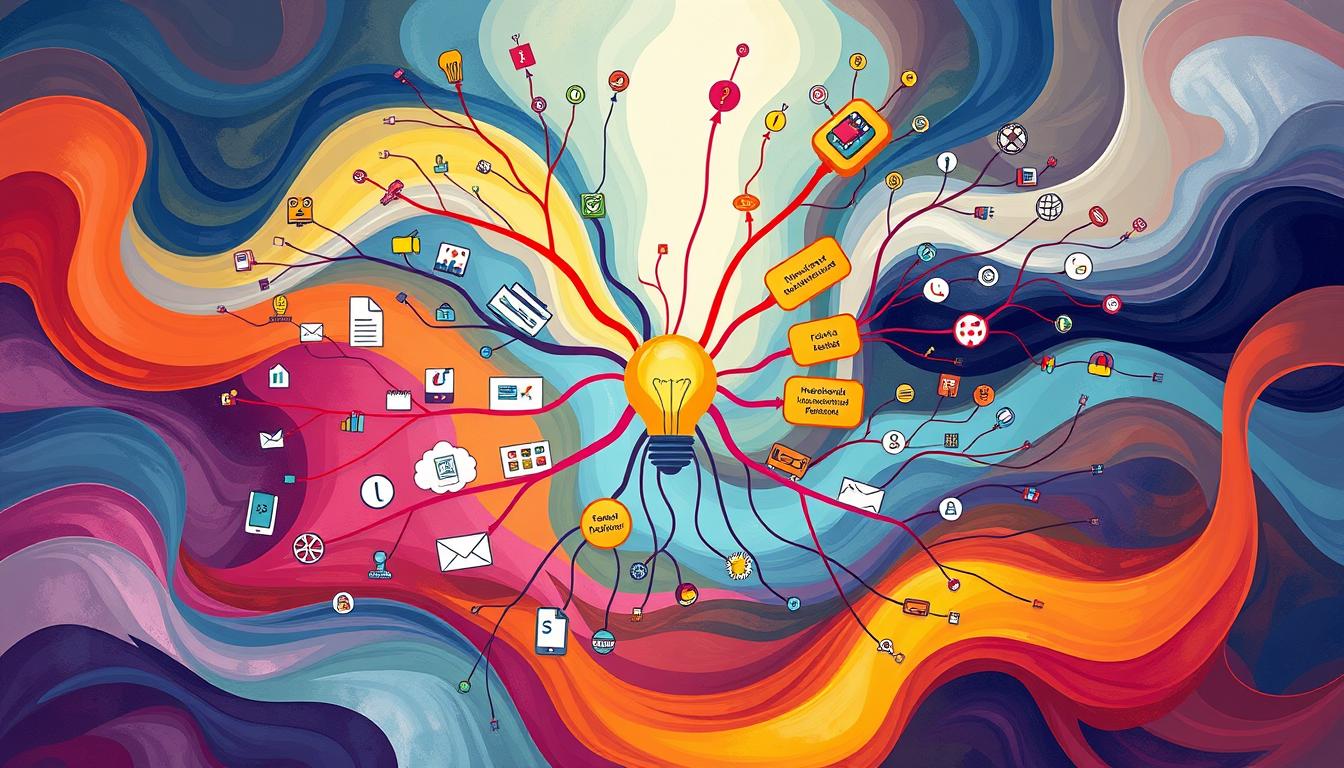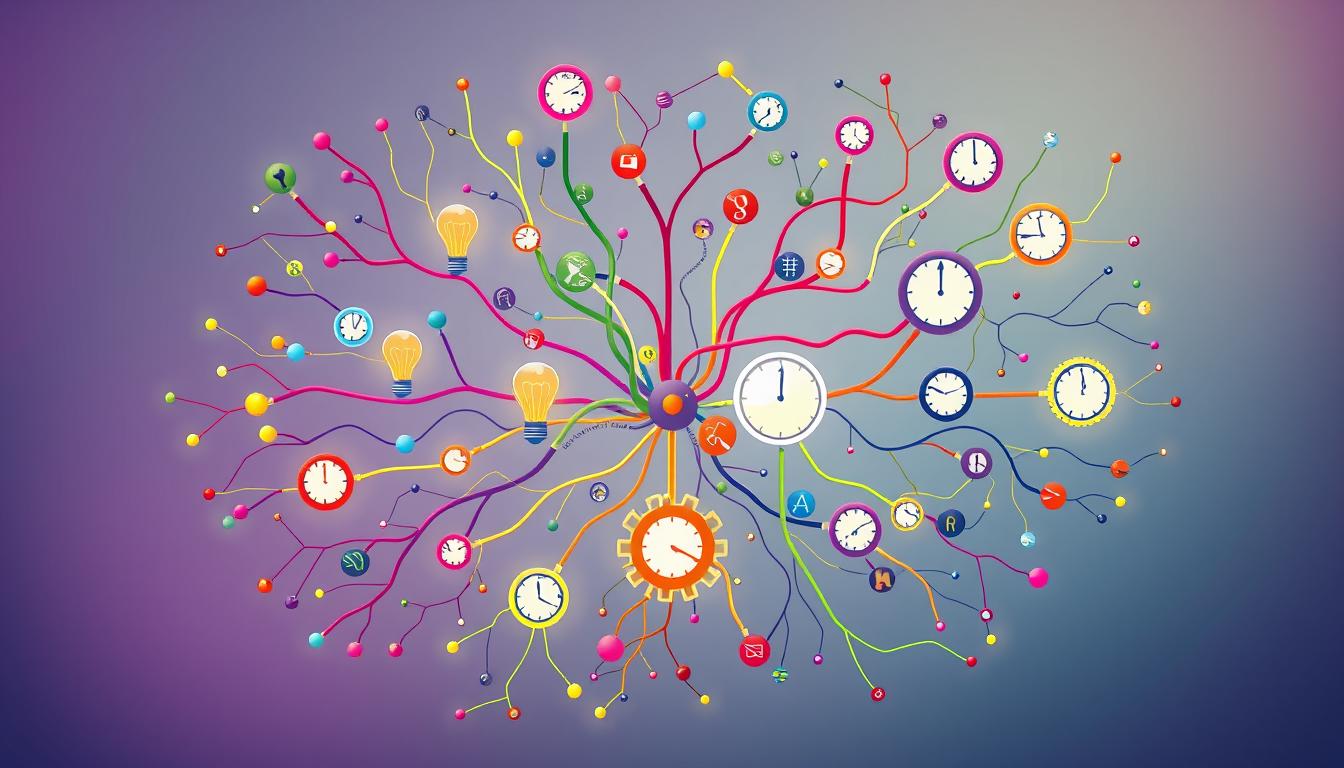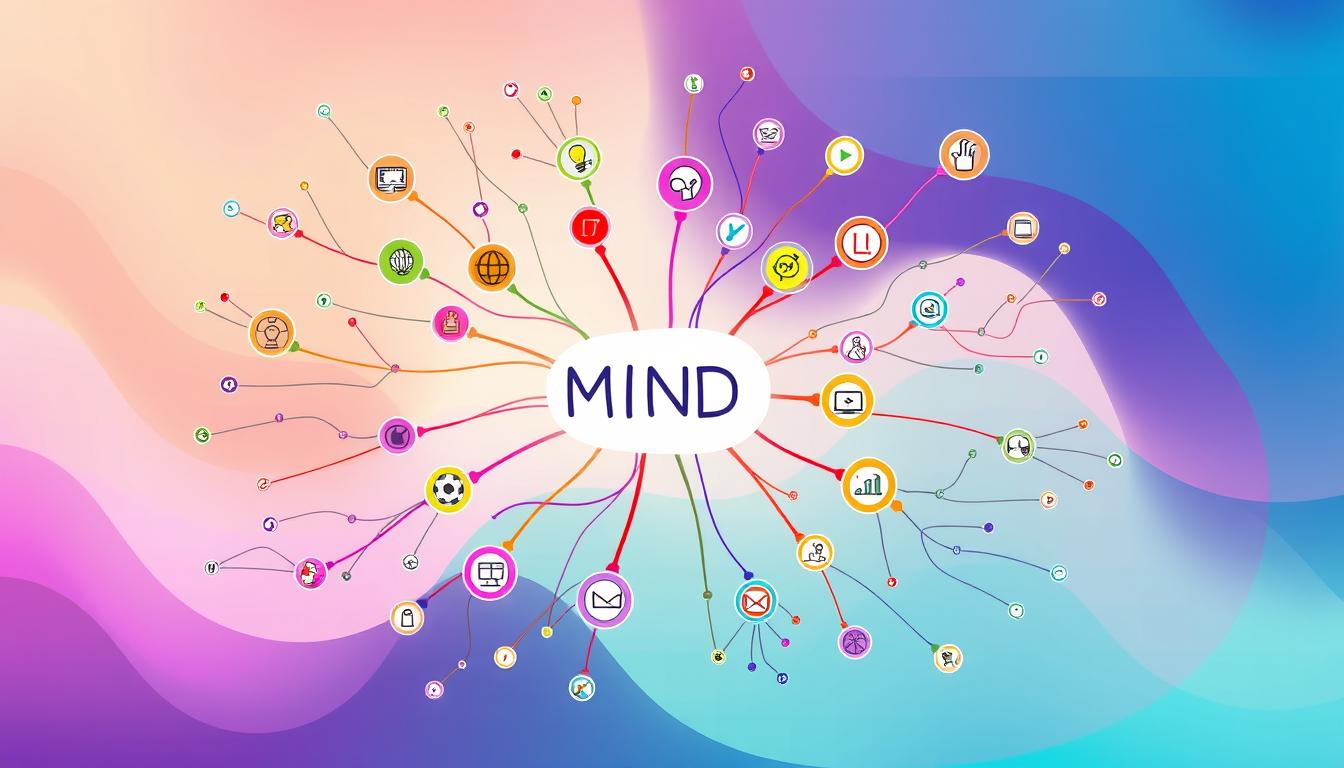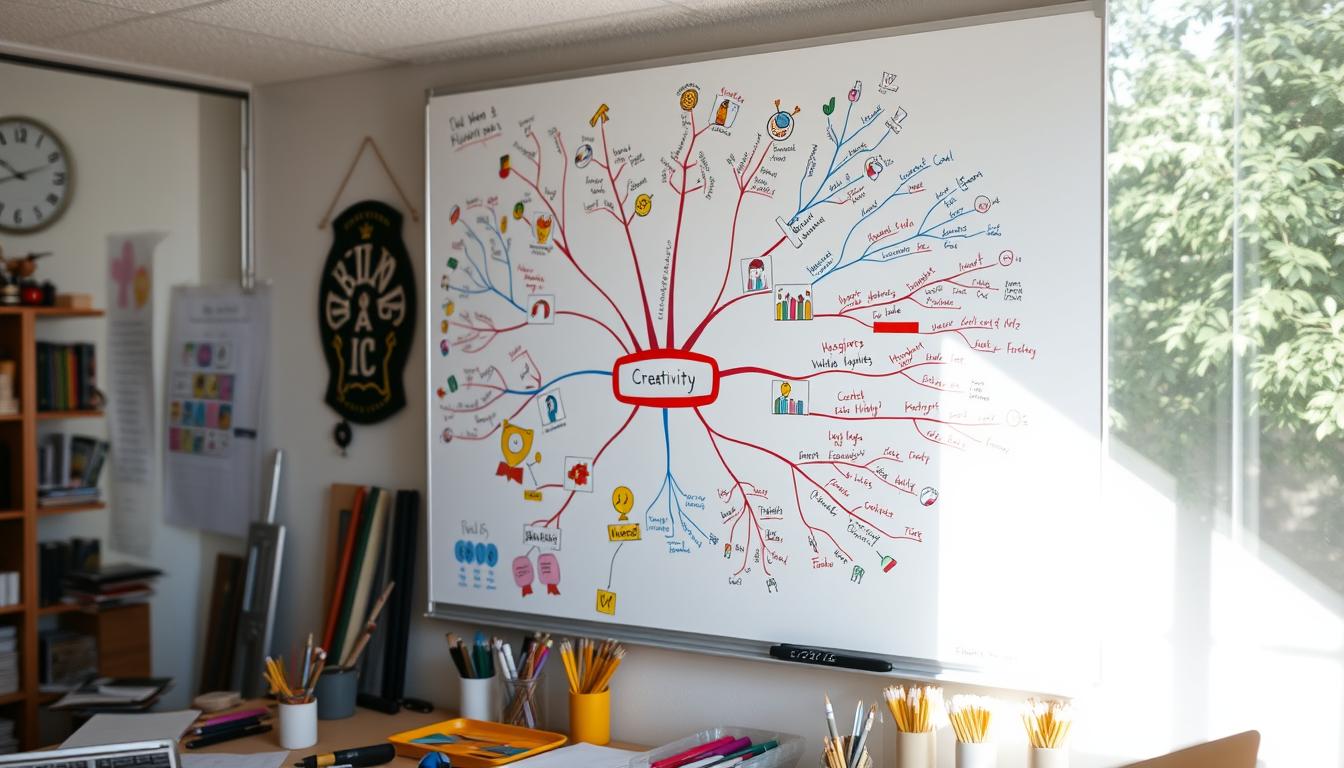Last Updated on December 9, 2025
In today’s world, we face a deluge of information, making complex ideas seem daunting. Mind mapping emerges as a potent tool for visually organizing this information. It simplifies complex subjects, transforming disorganized thoughts into a coherent structure. This method significantly boosts your productivity in Mind Mapping. Research indicates that mind maps can increase retention by 10-15%, leading to a deeper grasp of the material.
This article will guide you through the evolution of mind mapping techniques and the basics of creating effective mind maps. It will highlight how mind mapping is beneficial in education and project management, making it easier to handle complex ideas. You’ll learn how brainstorming techniques are enhanced by visualizing your thoughts, leading to better results whether working alone or with others. Let’s explore the realm of mind mapping and how it can change your approach to problems and projects.
Key Takeaways
- Mind mapping enhances understanding by breaking down complex concepts.
- It can boost productivity by an impressive average of 23%.
- Visual aids improve the clarity and coherence of content, making presentations more effective.
- Templates and collaboration tools streamline the mind mapping process.
- Visual learning through mind mapping leads to better retention and organization of ideas.
- Mind mapping fosters creative problem-solving and participative decision-making.
Introduction to Mind Mapping
Mind mapping is a technique for organizing thoughts and ideas visually. It breaks down complex information into a graphical format. Since the 1970s, thanks to Tony Buzan, it has become popular worldwide, used by over 250 million people.

Mind mapping boosts creativity and enhances brainstorming. It moves beyond linear note-taking, allowing ideas to connect freely. The central idea is the core, with related thoughts branching out, offering a comprehensive view.
Creating mind maps by hand or using software offers numerous benefits. It’s useful for project planning, decision-making, studying, and presentations. Mind maps improve note-taking, memory, problem-solving, and decision-making by illustrating idea connections.
Mind mapping merges art and science, combining logic and imagination. The C.O.W! method—Capture, Organize, Overview—gives you control over brainstorming. This makes the process not only productive but also enjoyable.
The Evolution of Mind Mapping Techniques
The history of mind mapping is rich and transformative. It began in ancient times, with the 3rd century’s Porphyry of Tyros and his Arbor Porphyriana model. This method allowed for a structured visualization of knowledge, aligning with the brain’s natural thought processes.
In the late 1960s, British psychologist Tony Buzan reignited interest in mind mapping. He introduced a new approach to visual diagrams, highlighting that traditional linear outlines don’t mirror our brain’s workings. Buzan’s major contribution came in 1996 with The Mind Map Book. This publication effectively popularized the technique, showcasing its benefits in the creative process.
Studies show that engaging both sides of the brain boosts memory retention and productivity. Modern research indicates that mind mapping can increase long-term memory by 10-15%. This makes it valuable for learning and problem-solving. The evolution of mind mapping reflects a shift towards non-linear thinking, enabling users to create connections and insights not possible with traditional methods.
Today’s mind mapping tools enable users to brainstorm, take notes, and simplify complex ideas. By using this technique, you can better organize your thoughts and boost creativity. Explore mind mapping tools, like time management tools, to enhance learning and retention.
Understanding the Basics of a Mind Map
The essence of a mind map lies in its central idea, branching out into subtopics. This hierarchical structure not only organizes thoughts but also enhances comprehension. It provides a clear layout.
Designing a mind map encourages brainstorming, allowing you to explore topics from different angles. As you expand your ideas, you engage deeply with the material. This makes connections that deepen your understanding.

Using images, colors, and lines in your map creates dynamic connections between concepts. This sparks creativity and promotes effective learning. Studies confirm that such visual tools improve retention and academic performance. By adopting these techniques, you can create a strong framework for organizing your thoughts efficiently.
The Benefits of Mind Mapping in Learning
Mind mapping is a powerful tool for enhancing your learning experience. Its unique visual structure engages your cognitive functions, promoting effective learning strategies for complex topics. By organizing information visually, mind maps break down subjects into manageable chunks, significantly improving memory retention.
Research shows that mind mapping can enhance retention by up to 20% to 32%. Some studies even report higher figures. This improvement comes from mind maps’ ability to connect new knowledge to existing knowledge. This connection makes learning more engaging, leading to better comprehension.
Mind mapping not only improves recall but also sparks creativity. Its visual format allows for exploring new ideas and relationships among concepts. Students often report increased productivity and faster task completion, especially during intense study periods.
- Enhances visual memory engagement
- Facilitates connections between ideas
- Aids in understanding intricate relationships
- Boosts creativity through a structured approach
Integrating mind mapping into your study routine can revolutionize your learning process. It leads to successful academic outcomes and deepens your understanding of the material. Make it a regular practice to fully benefit from its advantages.
Mind Mapping Productivity
Integrating mind mapping into your daily routine can significantly boost productivity. This method simplifies complex information and tasks through visual organization. It streamlines your workflow, enhancing efficiency.
Enhancing Your Workflow with Mind Mapping Techniques
Adopting mind mapping in your workflow can be life-changing. It helps you identify and organize tasks clearly. Tools like Mindmeister, Miro, and Mural.co make it simple to create these maps. They combine logical detail with creative visualization, balancing your brain’s functions.
Boosting Efficiency Through Visual Organization
Visual organization through mind maps improves clarity and efficiency. Users report achieving remarkable results, like completing 20 hours of work in 6 hours. This efficiency comes from transforming text into a more accessible format. Mind maps are flexible, accommodating different learning styles, especially visual ones. This leads to a notable increase in productivity, allowing you to work more effectively.

Mind Mapping as a Collaborative Tool
Using mind mapping in group work can revolutionize your team’s approach to creativity and problem-solving. This method enables a shared visual space, boosting engagement and sparking new ideas. When everyone brings their unique perspectives, the team’s collective insights align towards common goals.
Fostering Team Creativity
Integrating mind mapping into your team’s routine can yield significant outcomes. Studies show a 40% boost in idea generation with mind mapping. Teams using these tools are 30% more likely to find connections between unrelated concepts. This sparks *team creativity*, encouraging your group to explore new possibilities. Moreover, mind mapping can cut meeting times by up to 25%, helping your team stay focused.
Platforms like EdrawMind and MindMeister offer advanced features for visual collaboration. EdrawMind boasts over 700 cliparts, while MindMeister includes voting and tracking individual contributions. These features energize your team, leading to a more cohesive environment. Active participation enhances problem-solving and decision-making, as everyone shares solutions and ideas.
Creating a collaborative culture through mind mapping enriches your team’s creative output and fosters a stronger commitment to shared goals. As your team engages in these dynamic interactions, the potential for innovative ideas and successful projects grows exponentially.
Mental Mapping and Its Impact on Problem Solving
Mental mapping has become a key tool for improving problem-solving strategies. It breaks down complex issues into simpler parts. This method allows you to visualize problems, analyze relationships, and explore different viewpoints. It leads to better decision-making in various situations.
Using mental mapping enhances understanding and critical thinking, opening doors to creative problem-solving. Studies reveal that over 250 million people globally use mind mapping to find innovative solutions. It helps organize thoughts visually, spotting knowledge gaps and challenging assumptions.
In classrooms, mental mapping boosts students’ information retention and recall. For example, medical students saw a 10% increase in long-term memory retention with mind mapping. Children’s word recall also improved by 32% compared to traditional lists.
Adding mental mapping to your problem-solving arsenal offers significant advantages. It promotes teamwork, as people can combine their mental maps for a shared understanding. This collaborative effort leads to superior solutions and empowers everyone to share their unique insights.
In conclusion, mental mapping bridges creativity and analytical thinking, making it a crucial tool for effective problem-solving. Adopting this method can profoundly enhance your ability to address challenges creatively and efficiently.
Applying Mind Mapping in Project Management
Mind mapping can revolutionize your project management approach by boosting clarity and organization. It simplifies complex project structures, aiding in defining project scope and priorities through effective task breakdown. Visual representation promotes efficiency in planning, ensuring all project aspects are well-connected.
Using mind maps can greatly enhance decision-making. They make it easier to visualize options and data, simplifying informed choices. When working with your team, mind maps improve communication and task delegation, boosting teamwork. Tools like Xmind offer features for project management, such as real-time collaboration and tracking, that streamline workflows.
Mind mapping in your project lifecycle aids in better planning and analysis. You can turn your initial mind map into Gantt charts, managing your project timeline with clear deadlines and milestones. Visual aids improve task monitoring and control, making it easier to oversee hundreds or thousands of project resources.
Implementing mind mapping not only aids in problem-solving but also accelerates meeting processes. It efficiently captures key information and meeting minutes, providing a comprehensive project status overview. This facilitates clear communication about progress and tasks. By adopting these project management techniques, you can significantly boost your project’s success and productivity.
To enhance your project management effectiveness, explore strategies for improving productivity. With the right tools and techniques, you can transform your project management approach.
Integrating Mind Mapping with Productivity Tools
By integrating digital mind mapping with productivity tools, you can greatly improve your project management and brainstorming. Tools like MindMap AI and Cacoo enable software integration that boosts your idea’s effectiveness. These platforms let you add links, attachments, and notes, organizing your thoughts and materials in one place.
Using software for mind mapping offers many benefits. Unlike hand-drawn maps, which are quick but limited, digital maps can be updated easily without starting over. This saves time, allowing you to focus more on your ideas.
Studies reveal that mind maps with words, images, and colors improve information retention sixfold over text alone. Tools like MindMap AI make collaboration smooth, allowing team members to contribute to the map. This not only enriches discussions but also strengthens team bonds.
- Effortless sharing of ideas leads to enhanced group productivity.
- Makes complex ideas clearer and manageable through visual representations.
- Stimulates creative thinking by suggesting connections, breaking mental blocks.
Integrating mind mapping with productivity tools leads to a more efficient and personalized approach to project work and brainstorming. Adopting these technologies will improve your output and keep your team focused and engaged during the creative process.
Conclusion
Mind mapping emerges as a game-changer, boosting your productivity and creativity. It’s beneficial for professionals, students, and creatives alike. By starting with a central idea and expanding into subtopics, you tap into a deeper understanding. This approach stimulates both sides of your brain, fostering innovative thinking.
It simplifies brainstorming, project planning, and memory recall. Mind mapping’s visual nature makes it a powerful tool for organizing thoughts. It aids in decision-making and problem-solving, thanks to tools like EdrawMind. This software offers over 700 cliparts and collaborative features, making mind mapping a fun and productive activity.
By adopting mind mapping, you unlock a wealth of creative solutions. This leads to clearer communication and more effective project management. In essence, mind mapping is a key to unlocking success in various areas of your life.








